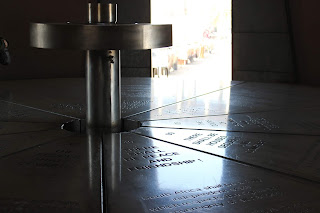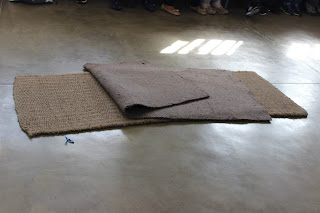On the Road Again - to Southern Africa! Post One
The adventure continues - this time to South Africa, Zimbabwe, Namibia, Botswana, and Zambia.
I had planned to blog as we traveled, but decided to leave the computer behind. We had severe weight restrictions for our luggage, as one leg of our trip involved a round-trip in a small private plane to the Lower Zambezi River in Zambia. As a result, I couldn't download any pictures from my Canon Rebel camera card. I did post a few iPhone pictures and videos on Facebook, some of which may reappear here.
On the Road Again is a way to share our travels with friends – and to remember what we did ourselves. I hope you enjoy it, even though this time I am writing about events that took place weeks ago.
I have always wanted to go to Africa to see the animals there. As a child, I planned to become a veterinarian, and dreamed of working in Africa as a wildlife vet for some of the world's most charismatic and endangered animals. Ninth grade biology taught me that I had no aptitude for the academic work I would need to pursue that dream, so I diverted my professional plans, but I continued to dream of seeing elephants, zebras, rhinos, giraffes, and hippos in the wild. It's been 46 years since 9th grade biology, so it felt like the time had come to fulfill that modified dream.
We traveled with Smithsonian Study Tours, a group of 17 people, accompanied by the Smithsonian's lead expert on mammals, Don Wilson, and led by an African guide and a host of on-the-ground trackers and guides in each country.
The safari portions of the trip were bookended by visits to Johannesburg and Cape Town, South Africa. In Johannesburg, we visited the Kliptown monument to the African National Congress's Freedom Charter (https://en.wikipedia.org/wiki/Freedom_Charter), and then went to the monument and museum to the 1976 Soweto Uprising to meet with Antoiette Sithole, the sister of Soweto martyr Hector Pieterson, the 12-year-old whose killing by police began the violence (https://en.wikipedia.org/wiki/Hector_Pieterson). The anniversary of his death, June 16, is celebrated each year as Youth Day in South Africa, and the area was full of children marking the occasion on their last day of school before the winter holidays, June 14. After that, we went to Nelson Mandela's house, where his children's umbilical cords are buried in the yard, and where he returned after 27 years of prison.
At the end of our trip, we also went to notorious Robben Island, just off the coast of Cape Town, where Mandela spent 18 years breaking limestone into gravel as punishment for advocating the end of white supremacist rule in South Africa. We were guided by a former Robben Island political prisoner, Derick Basson, who was sentenced to the prison as a teenager for sabotage. Mr Basson showed us a mat that served as a typical bed for a prisoner before international attention brought about improved conditions in the 1980s. He also showed us Nelson Mandela's cell, a claustrophobic, bare cage separated by stone walls from the adjoining cells.
During the day, Mandela and his fellow prisoners cut limestone from a quarry on the prison grounds. They dug a small cave in the rock face to give temporary respite from the heat of the sun for their meals. About 70 percent of the prisoners were college educated – lawyers, doctors and professionals who had joined the ANC and PAC (Pan-African Congress) to fight the apartheid regime. The others, like Mr Basson, were uneducated, many illiterate, when they joined the cause. Instead of allowing their differences to divide them, the educated prisoners taught their compatriots in the small cave during work breaks. By the time they were released, many of the uneducated prisoners were able to pass university entrance exams. They called the cave the University of Robben Island. The pile of stones near the cave was made in 1993 at a reunion of former prisoners. Mr. Mandela picked up a stone and laid it down at the entrance to the mine. One by one, the others did the same. The pile has remained ever since as a testament to those who were imprisoned here and refused to let it defeat them.
When I was a college student in the late 1970s, I followed the news of Nelson Mandela and the Soweto Uprising with great interest. I was active in forming our local South Africa Support Group, which advocated that the school divest itself from stock in companies doing business in South Africa until the system of apartheid – enforced racial separation and violent oppression – was abolished. Our effort was ultimately successful, and along with similar efforts around the country, helped to focus national attention on the issue and pressure South Africa to respond.
Nelson Mandela was released from prison on Sunday, February 11, 1990. We heard the news on the radio in the car as we drove to church for Anna's baptism. To find myself walking the very ground where Mandela and the Soweto martyrs walked was moving and affirming. To see the current South Africa, transformed by Mandela's leadership and a rigorous truth and reconciliation process into a democratic country that strives to embody equality and empowerment – although it falls far short of achieving them – gives me hope for our own nation and our local efforts to come to terms with our own legacy of slavery and systemic inequity.
NEXT: The Animals of Africa
I had planned to blog as we traveled, but decided to leave the computer behind. We had severe weight restrictions for our luggage, as one leg of our trip involved a round-trip in a small private plane to the Lower Zambezi River in Zambia. As a result, I couldn't download any pictures from my Canon Rebel camera card. I did post a few iPhone pictures and videos on Facebook, some of which may reappear here.
On the Road Again is a way to share our travels with friends – and to remember what we did ourselves. I hope you enjoy it, even though this time I am writing about events that took place weeks ago.
* * *
I have always wanted to go to Africa to see the animals there. As a child, I planned to become a veterinarian, and dreamed of working in Africa as a wildlife vet for some of the world's most charismatic and endangered animals. Ninth grade biology taught me that I had no aptitude for the academic work I would need to pursue that dream, so I diverted my professional plans, but I continued to dream of seeing elephants, zebras, rhinos, giraffes, and hippos in the wild. It's been 46 years since 9th grade biology, so it felt like the time had come to fulfill that modified dream.
We traveled with Smithsonian Study Tours, a group of 17 people, accompanied by the Smithsonian's lead expert on mammals, Don Wilson, and led by an African guide and a host of on-the-ground trackers and guides in each country.
Post One: The Legacy of Apartheid and Mandela
The safari portions of the trip were bookended by visits to Johannesburg and Cape Town, South Africa. In Johannesburg, we visited the Kliptown monument to the African National Congress's Freedom Charter (https://en.wikipedia.org/wiki/Freedom_Charter), and then went to the monument and museum to the 1976 Soweto Uprising to meet with Antoiette Sithole, the sister of Soweto martyr Hector Pieterson, the 12-year-old whose killing by police began the violence (https://en.wikipedia.org/wiki/Hector_Pieterson). The anniversary of his death, June 16, is celebrated each year as Youth Day in South Africa, and the area was full of children marking the occasion on their last day of school before the winter holidays, June 14. After that, we went to Nelson Mandela's house, where his children's umbilical cords are buried in the yard, and where he returned after 27 years of prison.
 |
| The Freedom Charter Monument |
 |
| Children gather for Youth Day |
 |
| Antoinette Sithole |
 |
| The death of Hector Pieterson (his sister is at left) |
 |
| From Mandela's house at 8115 Orlando West |
 |
| The tree in front of Mandela's house |
During the day, Mandela and his fellow prisoners cut limestone from a quarry on the prison grounds. They dug a small cave in the rock face to give temporary respite from the heat of the sun for their meals. About 70 percent of the prisoners were college educated – lawyers, doctors and professionals who had joined the ANC and PAC (Pan-African Congress) to fight the apartheid regime. The others, like Mr Basson, were uneducated, many illiterate, when they joined the cause. Instead of allowing their differences to divide them, the educated prisoners taught their compatriots in the small cave during work breaks. By the time they were released, many of the uneducated prisoners were able to pass university entrance exams. They called the cave the University of Robben Island. The pile of stones near the cave was made in 1993 at a reunion of former prisoners. Mr. Mandela picked up a stone and laid it down at the entrance to the mine. One by one, the others did the same. The pile has remained ever since as a testament to those who were imprisoned here and refused to let it defeat them.
When I was a college student in the late 1970s, I followed the news of Nelson Mandela and the Soweto Uprising with great interest. I was active in forming our local South Africa Support Group, which advocated that the school divest itself from stock in companies doing business in South Africa until the system of apartheid – enforced racial separation and violent oppression – was abolished. Our effort was ultimately successful, and along with similar efforts around the country, helped to focus national attention on the issue and pressure South Africa to respond.
Nelson Mandela was released from prison on Sunday, February 11, 1990. We heard the news on the radio in the car as we drove to church for Anna's baptism. To find myself walking the very ground where Mandela and the Soweto martyrs walked was moving and affirming. To see the current South Africa, transformed by Mandela's leadership and a rigorous truth and reconciliation process into a democratic country that strives to embody equality and empowerment – although it falls far short of achieving them – gives me hope for our own nation and our local efforts to come to terms with our own legacy of slavery and systemic inequity.
NEXT: The Animals of Africa








Comments
Post a Comment